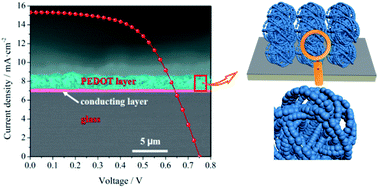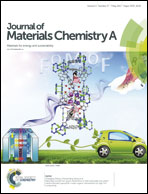Fabrication of PEDOT films via a facile method and their application in Pt-free dye-sensitized solar cells†
Abstract
Poly(3,4-ethylenedioxythiophene) (PEDOT) has attracted much attention in the application of dye-sensitized solar cells (DSSCs) due to its outstanding photovoltaic property. PEDOT films were synthesized in a three-electrode system with a direct-current power supply to control the polymerization process, leading to a simplification of the electrochemical polymerization procedure. The morphology of PEDOT can be represented as a micro-sphere with three-dimensional network-like structures aggregated with plenty of nanoparticles. The polymerization voltage, polymerization time and the concentration of 3,4-ethylenedioxythiophene (EDOT) exhibited a significant influence on the photovoltaic characteristics of PEDOT films. Impressively, the DSSCs with optimum PEDOT films as counter electrodes (CEs) reached the highest power conversion efficiency (η) of 6.401%, which was comparable to that of a cell with platinum (Pt) CEs (6.493%). After modification by reduced graphene oxide (rGO), DSSCs equipped with PEDOT/rGO CEs reached an η of 7.115%, with an enhancement of 9.58% compared to that of Pt CEs. Thus, the rGO-coated network-like PEDOT can be considered as an economical alternative component to expensive Pt electrodes.



 Please wait while we load your content...
Please wait while we load your content...